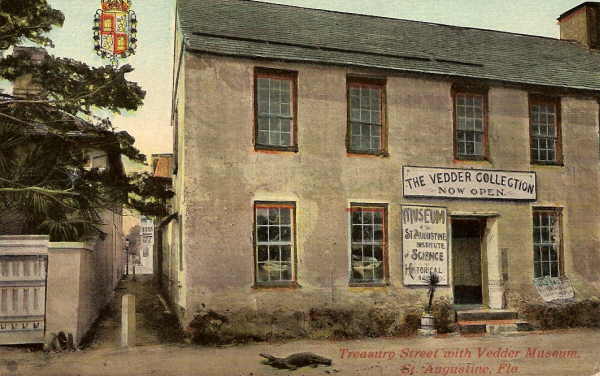
 |
The Vedder Museum |
|
Home Attractions List Books Poster Gallery Timeline
|

Before Florida had enough roads for there to be such a thing as a roadside zoo, and before Robert Ripley had ever collected his first unusual curio (Believe It, Or Not!), in other words, before there was such a thing as the typical Florida Tourist Attraction of the Golden Age of Roadside Tourism, the Vedder Museum had anticipated them all. It had the live alligators and snakes, the colorful birds, the sensationalized exhibits promoted with breathless advertisements (one ad promised a "Monster Man-Eater Shark," a "Monster Sun Fish... the largest one in the world" and the "skull of an aboriginee, plainly showing indentation made by stone battle-axe" among the wonders to be seen) and, of course, a gift shop offering "Live Alligators for sale, boxed for shipment." Dr. John Vedder, his title as "Doctor" stemming not from a University but the remnant of a short stint practicing as a self-taught Dentist, was born in Schenectady, New York, on July 22, 1819. He seems to have been a bit of an adventurer, traveling and working at various times and places as a soldier, blacksmith, machinist, locomotive engineer, inventor, dentist, taxidermist, and, in his final occupation, museum and zoo curator. In his travels he had gathered a large collection of natural oddities and curiosities, including many animal specimens he stuffed and mounted himself. He turned them into a traveling display for a time and then, in the 1880's, opened a permanent museum in an old colonial era house on the corner of Bay and Treasury Streets in St. Augustine. A major part of his attraction was also an exhibit of live animals, including collections of snakes, birds, alligators, and some other native and exotic wildlife.
Vedder died in 1899 and his museum was purchased by the St. Augustine Historical Society, who kept it open until the building burned down and the collection was destroyed in 1914. The Society had recovered from the loss enough by 1918 to purchase the Gonz�lez-Alvarez House which they still operate today as "The Oldest House." |
|
Note: the attractions profiled on this site are no longer in business. Return To Florida's Lost Tourist Attractions
Postcard image from the author's collection.
This site Copyright (c) 1997-2011 by Robert H. Brown
|